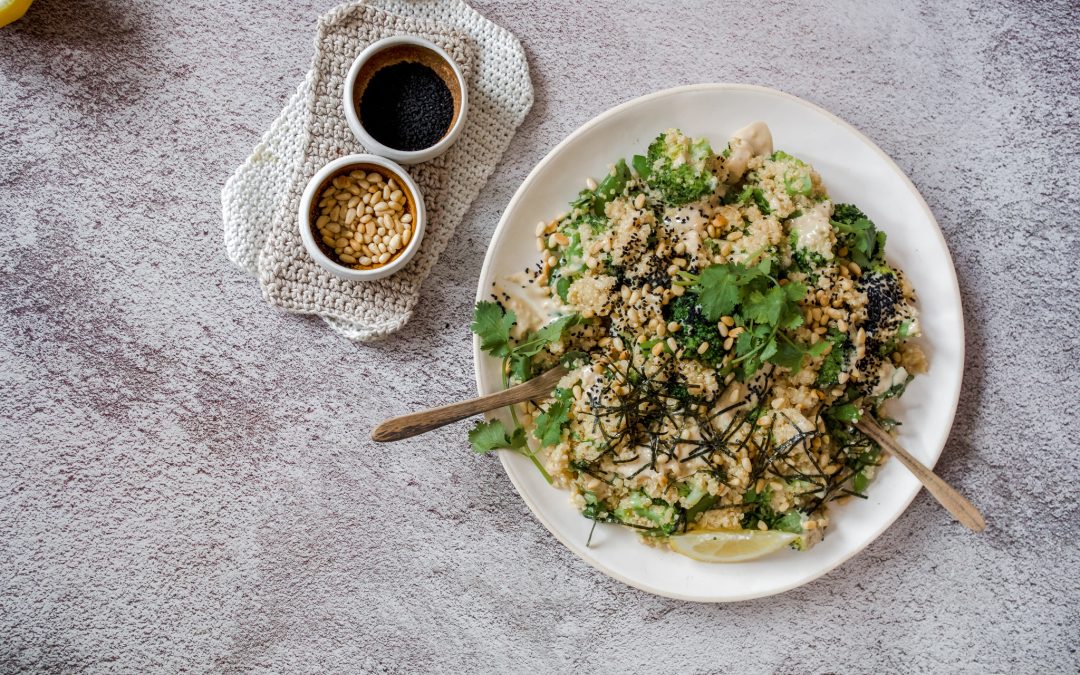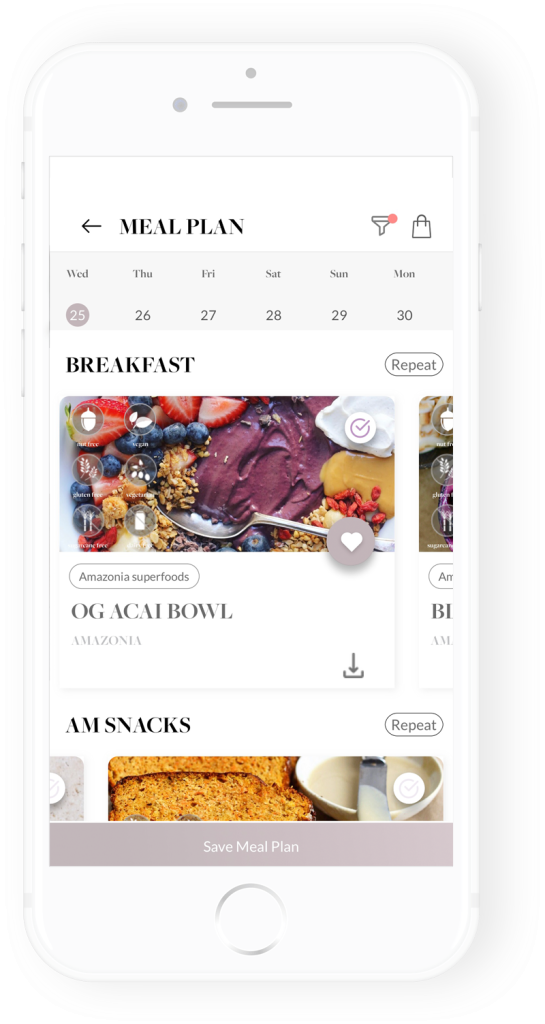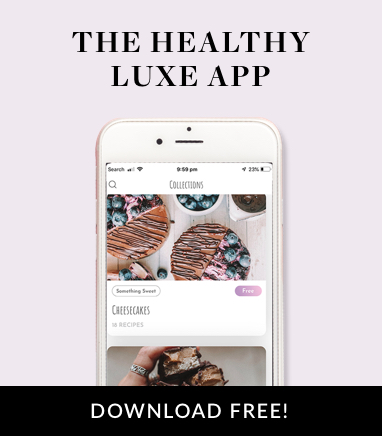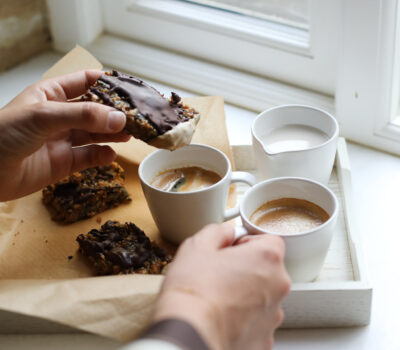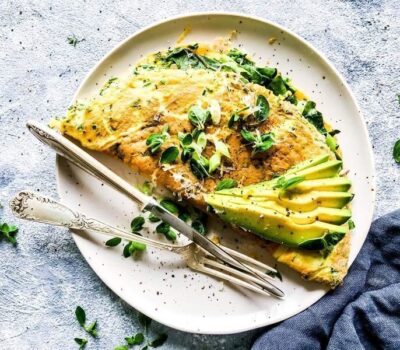How to make the most of your subscription to our in-app meal planner…
As we enter into the second half of January and settle back into our daily routines, so often accompanied by stress, it may be a good time to reflect on some of the promises we made to ourselves in our list of ‘new year resolutions’. Often developing better health habits is amongst the goals we set… it may be giving up smoking, exercising more, drinking less (or no) alcohol, detoxing, losing weight… the list goes on. Sometimes these goals begin with ‘kick start’ type challenges, for example we have ‘Dry January’, ‘Veganuary,’ Whole 30 challenge, various gym challenges, etc.
If your health goals relate to making dietary changes and maintaining balance, Healthy Luxe app is here to support you. We are all different and there is no ‘one size fits all’ where nutrition is concerned. With over 400 healthy recipes, we now have a meal planner, with nutrition panels for every recipe. These panels are intended to serve as guidelines. We have often said that nutrition and weight management is far more than ‘calories in vs calories out’ which is a flawed theory on so many levels. However this does not mean it is not helpful to be aware of calorie value, as long as it is in the context of the nutrient density which accompanies these calories and whether the food nourishes or adds to toxic and sugar overload, the latter placing enormous pressure on our metabolic function.
All of our recipes use whole foods, which are nutrient dense and even our sweet treats contain minimal sweeteners involving little to no processing (e.g. whole dates, bananas, honey, maple syrup). None of our recipes contain cane sugar, agave syrup, corn syrup or rice syrup. You will now be able to see at a glance the amount of natural sugars per serve, the percentage of recommended daily intake this represents, as well as additional nutrients in the treat itself. You may be surprised to know just how few nutrients are in commercial sweet treats, and what is there instead. Below is a comparison of one of our most popular desserts, Sticky Date Pudding, with a commercial equivalent to illustrate this. Equally, you may be surprised to know how much sugar is in treats marketed as healthy.
Sticky Date Pudding
Sticky Date Pudding is a delicious dessert and one of our favourite indulgences. It is also a treat which is heavier on calories and sugar than some of our other recipes which needs to be considered in the context of the rest of your diet. We still believe this can be consumed and enjoyed in moderation, it is satiating, provides nutrients, dietary fibre and promotes gut health. We have compared our sticky date pudding (recipe on our app!) with a commercial variety below. Whilst there is less than 50 calorie difference per 100g (ours is the lesser of the two), our bigger concern is the distinct lack of functional foods and presence of additives in the commercial variety.

| Healthy Luxe Sticky Date Pudding | Commercial Sticky Date Pudding | |
| Ingredients | Almond milk, dates, almond flour, free range eggs, coconut paste, hulled tahini, coconut sugar, baking powder, Himalayan salt (all organic ingredients) | Sugar, dates, wheat flour, water, margarine [vegetable fats and oils, water, salt, milk solids, emulsifiers (vegetable – soy lecithin, 471, 472c), flavour, citric acid, antioxidant (306), colour (carotene)] glucose syrup, egg, fondant, cream, thickener (1412), raising agents (450, sodium bicarbonate), emulsifiers (vegetable – 477, 471, 475), colour (150c), vegetable gums (406, 405), natural flavours |
| Calories per 100g | 299 | 344 |
| Gluten Free | Yes | No |
| Dairy Free | Yes | No |
| Nut Free | No | None in listed ingredients, however label states may contain traces of nuts |
| Organic | Yes | No |
| Protein per 100g | 6.4grams (132g serving providing 17% RDI) | 2.7g (132g serving providing 7% RDI) |
| Carbohydrate per 100g | 27.6 grams | 54 grams |
| Sugars per 100g | 22.4 grams from whole foods (132g serving provides 33% RDI) | 39.2 grams mostly from highly refined sugars (132g serving provides 58% of RDi) |
| Fats per 100g | 17.4 grams total 6.2 grams saturated | 12.7 grams total 7.5g saturated |
| Fibre | 61mg (132 g serving provides 14% of RDI) | |
| Sodium | 177mg | 282mg |
| Micronutrients (% of daily recommended intake per serving) | Magnesium 61mg (25%) Vitamin E 4mg (53%) | None listed |
| Additives | Organic baking powder | 471 – emulsifier (mono and di glycerides from fatty acids) 472c – emulsifier (citric acid esters of mono and diglycerides of fatty acids) 306 – antioxidant – Tocopherols 450 – diphosphate sodium bicarbonate 477 – Propane-1,2-diol esters of fatty acids 475 – Polyglycerol esters of fatty acids 150c – Ammonia caramel 405 – Propane-1,2-diol alginate 406 – Agar 1412 – thickener – distarch phosphate flavour ? fondant ? |
Our panels also provide a breakdown of macro nutrients (protein, fats, carbohydrates), as well fibre and micronutrients (vitamins and minerals) when in significant quantities*. In addition to the initial filter for dietary requirements including vegan, vegetarian, gluten free, dairy free, nut free and sugar cane free, there is an additional preference filter to assist with your objectives, being quick and easy, high protein, high complex carbohydrate, high fibre, promoting gut health, anti-inflammatory, high iron and high calcium. It is our intention to gradually increase our filters for specific nutrients to assist in learning food sources of particular vitamins and minerals, especially for those who know they are deficient (through blood tests or assessment by a health professional). The panels are intended to be a guide, to encourage curiosity around what nutrients good food brings, rather than counting calories and macros in a rigid and restrictive way.
We recommend choosing one or two key focus areas from the preference filter in order to ensure variety.
Once you have chosen and saved your meal plan, it is then very simple to check ingredients required and add whatever you need to your shopping list!
We hope Healthy Luxe app will help you on your own personal health journey. Find out more or download it here!
*Notes:
- There are many variables when it comes to nutrition, both individually and with in relation to nutrient diversity.
- Factors that influence composition of any food include conditions in which they are grown / raised, for example in plant based foods, quality of soil in which they are grown is important, transport and storage, as well as preparation (although cooking is taken into account in calculations). We recommend organic wherever possible to maximise nutrients and minimise toxic load.
- Nutrients listed in addition to macros reflect a good source of this particular nutrient.
- Phytonutrients are increasingly being studies for their health benefits, however are often unique to particular foods and data is not available. We have included additional specific information on a key ingredient for greater depth.
- RDI (recommended daily intake) recommends intake required to avoid deficiency (for nutrients)

